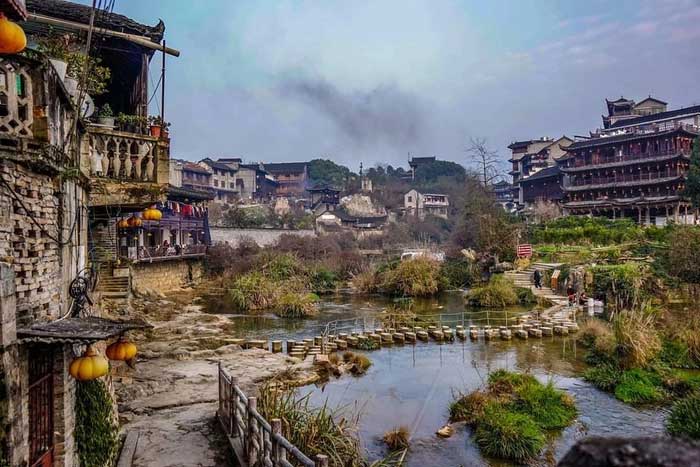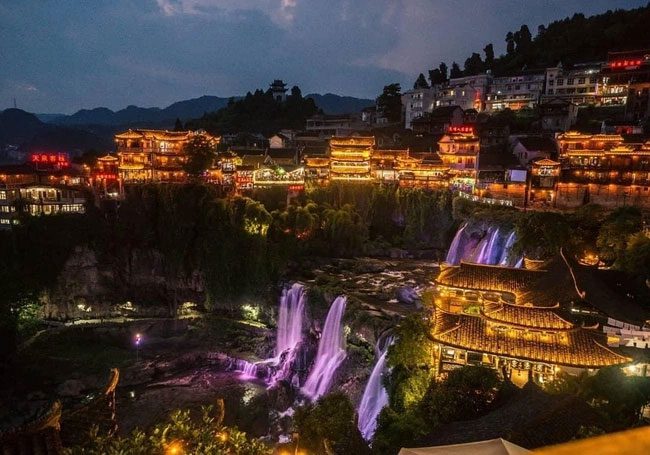Despite being precariously built beside a waterfall, these houses in this ancient town have remained standing for thousands of years.
The houses rely on just a few supporting pillars and are perched on cliffs next to a waterfall that has existed for over 2,000 years. This location gives the impression that even a strong gust of wind could cause the houses to sway or collapse. This place is known as the ancient town hanging by the waterfall. So, where is this, and why was it built here?
This is Wang Village, a town built on a mountain in the Vĩnh Thuận County of Hunan Province (China). In fact, this location was chosen by director Zhang Zhen to film “The Town of Fu Rong” (1986). With the popularity of the film, the town located in the middle and lower reaches of the Zhaoshui River was later renamed Fu Rong. Since then, Fu Rong Ancient Town has become one of the famous tourist destinations attracting a large number of visitors both domestically and internationally.

Fu Rong Ancient Town is a famous destination attracting many tourists due to its many ancient houses and picturesque scenery that resembles a fairyland.
Fu Rong Town is where the Tujia ethnic group first settled and established the Vĩnh Thuận Tujia government.
According to historical records, the leaders of each Tujia dynasty built a resort or a retreat next to the waterfall. Why did they choose such a strange construction site?
Experts say that Fu Rong Ancient Town is located in a unique and strategic position, with two vertical cliffs that are as sharp as knives. Therefore, if someone wants to ascend, they can only do so from two river docks. Easy to defend, difficult to attack, extremely strategic, is the distinctive characteristic of Fu Rong Town.

Aerial view of Fu Rong Town.
The Tujia people governed this area for more than 800 years. Throughout numerous dynasties and tumultuous wars, Fu Rong Town was extremely suitable when considering military safety. Additionally, this area has a wide riverbed, suitable for boats to navigate. As a result, it also served as a busy trade waterway in ancient times.
However, many still wonder why houses could be built elsewhere, but the ancients chose to build on the cliff?
Why have the houses built precariously beside the waterfall stood for 2,000 years without collapsing?

Fu Rong Town has many ancient houses, rich in Tujia tradition.
First, these are traditional houses. Experts believe that the architecture in Fu Rong Town reflects the characteristics of southern China, known as Diao Qu Lou, or hanging foot house. This is a type of stilt house built according to the slope of the mountain. Specifically, the rear half of the house is on the mountain surface, while the front half extends outward, supported by pillars called Diao Qu.
Second, building houses on cliffs saves land. This is an important reason. In ancient times, Wang Village (the old name for Fu Rong Town) had a scale comparable to that of modern-day Shanghai, where land was considered golden. Therefore, to have a living space and ensure safety, the residents continuously extended their houses outward to increase usable area. Even the part of the house that juts out over the cliff is supported by pillars.
Since ancient times, constructing a house required finding a location with stable and solid ground. So, why have these precariously built houses on the cliffs survived for thousands of years?

Fu Rong Town looks enchanting at night.
Experts analyze that this area was once underwater. The tectonic movements of the Earth caused a part of the rock to crack and fall. The rocks were eroded by water, gradually forming the geographical conditions we see today.
Therefore, the rocks in Fu Rong Town are formed from marine sediment, making them extremely solid. Moreover, the houses in this ancient town are all built away from areas with water seams. Thus, while the houses perched on the cliffs may appear dangerous, in reality, the ground is very stable, and the supporting pillars do not come into contact with water. Interestingly, the ancient houses in Fu Rong Town are all built from wood and do not use iron nails.

Fu Rong Town impresses tourists with its beautiful scenery.
The unique houses combined with the picturesque landscape of Fu Rong Town surely leave a strong impression on visitors whenever they come here.
Fu Rong Town is primarily inhabited by the Tujia people, one of the oldest ethnic minorities in China. This ethnic group primarily lives in regions across Hubei, Hunan, Chongqing, and Guizhou provinces. In addition to tourism, the local residents in Fu Rong Town develop several traditional crafts such as noodle making, smoked meat, and horn crafting.


















































